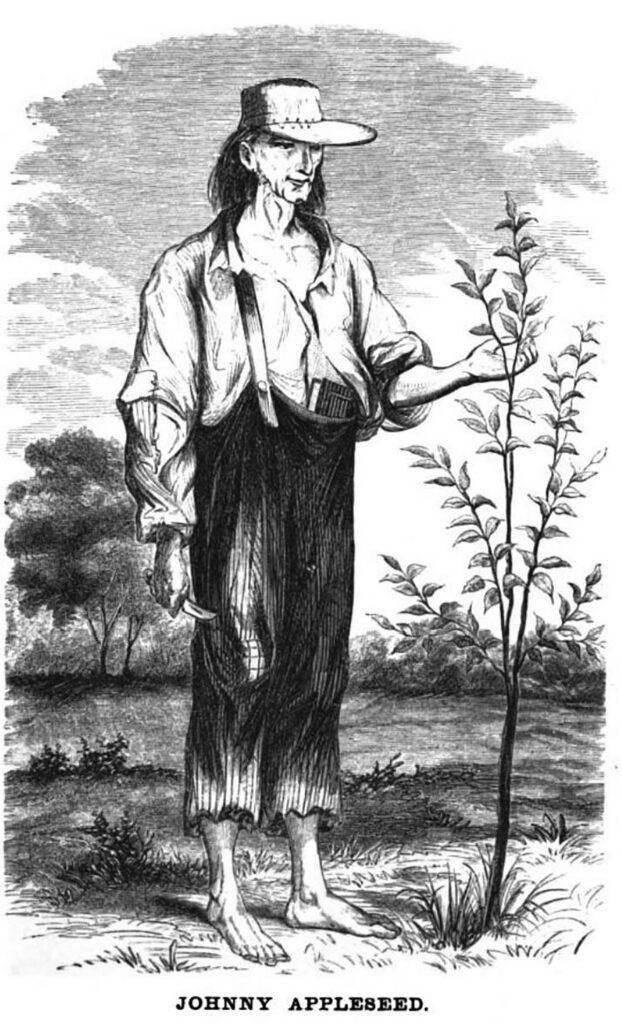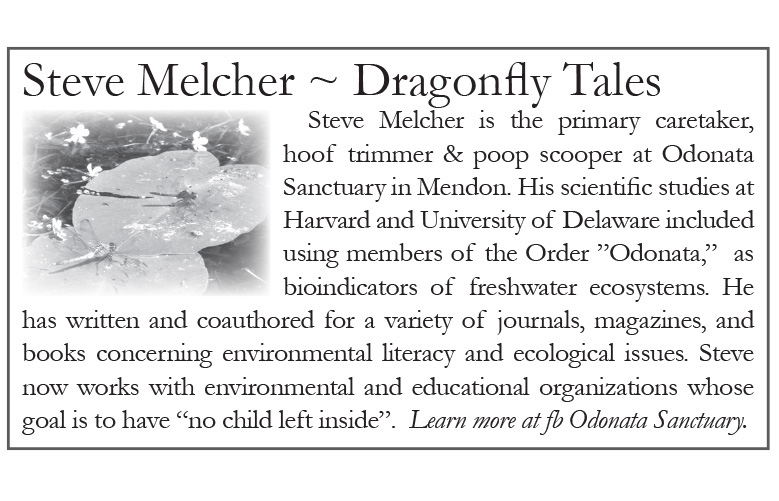Dragonfly Tales
- By STEVE MELCHER –
The Apple: As American as Apple Pie … Well Perhaps Not
Though Henry David Thoreau insisted that he much preferred the wild apple (“of spirited flavor”) to the civilized versions found in Massachusetts orchards, even he admitted that the occasional spirited bite was “sour enough to set a squirrel’s teeth on edge and make a jay scream.”
Fall! Here at Odonata Sanctuary, fall is the time to work on the BSF (Before the Snow Flies) list. Included on that list is apple gleaning. We do have several varieties of espaliered apple trees on the south facing side of the main house, but I’ve always found these to be too militant (“You there, up against the wall!) and far too much work. Like the berries of a few weeks earlier, I prefer to foray through the fields and forests to find the fruits of the forgotten wild apple tree.
On one such recent foray in a far part of the sanctuary, we found an aged gnarled tree only about 15 feet high but radiant with ripe red fruits ready to be relinquished to the apple cart. One of the monkeys in the crew climbed up and began her shaking and screeching and the apple rain began to fall. We all scrambled for the ripest of the ripe, saving the sorting for later, the four legged members of the family getting any that are not worthy of Forest’s strudel. While bantering and bobbing for apples, the topic of where apples came from came up. I was interested in how this particular apple tree might have prospered here. Was this robust tree once part of a larger orchard? Were the seeds pooped here by some meandering bear many years ago? But their question was not about this particular tree but concerned the origin of apples as a species. Where do apples originally come from? Most assume that the apples of American Pie, the apple of your eye and Johnny Appleseed are native to New York, at least the New World. Who knows where the food you take for granted originated? We know that potatoes that we associate with the Irish potato famine are native to Peru and that tomatoes of a wonderful Italian sauce are native to somewhere far from Rome. The Apple, it turns out, is native to what is now Kazakhstan! Originating in the Tien Shan mountains millions of years ago the apple has been a part of the human diet for thousands of years. But how did they get to the New World? Like many other treasures of the East, apples travelled to the Mediterranean and beyond via the Silk Road. Apples were introduced to our part of the world by colonists as early as the 17th century.
The first official apple orchard on the North American continent was planted by the Reverend William Blaxton in Boston in 1625, but even as early as 1607 Jamestown folks were eating apples grown from seeds and cuttings brought from Europe. But the apples of the early days in Europe and America were not grown for apple pies and strudels, their primary use was in the delightful fruity drink we know of as cider. Cider became a very popular drink in England after the Normans invaded and brought with them tasty apples from France. The New World brought that quest for quench with them in the form of cider apples. Most colonists grew their own apples and preferred to serve a fermented cider at meals instead of water, due to sanitation concerns. Even the kids had their share of watered down cider.
What about that Johnny Appleseed guy?

Yes, there really was a Johnny Appleseed. John Chapman, the apple toting fellow from Leominster, Mass, traveled the country with a bag of apple seeds and a tin pot nesting on his handsome head. He actually condemned grafting as wicked, insisting the only good apples come from seeds. John collected seeds mostly from cider mills in Pennsylvania and distributed them widely and wildly. These weren’t really good eating apples, they were used primarily again for cider. Johnny not only spread mouth puckering apples, he spread booze. Eventually the classic symbol of knowledge and health was ostracized by temperance activists of the times who pointed their finger at the apple as the source of alcoholic sin and proclaimed those that wished to be redeemed should burn their apple trees. Whew, and this tree that I am writing about survived all that. Imagine the stories these apples could tell. Perhaps the seeds of this tree were carried here by that sauntering bear or perhaps by some drunkard from New England visiting with a tin pot on his head.
Botany Lesson: Apples grow extremely well from seeds but today’s cultivated apples are propagated using cuttings and grafts.
This is because apples are an excellent example of a fruit that is an ‘extreme heterozygote’ (hetero= different and zygote=fertilized cell). Their genetic makeup includes variations, or alleles, that combine randomly and cause significant differences from each apple’s parents. Even the same apple parents can produce very unlike offspring very much like another heterozygous species, human beings.This means that rather than inheriting genes from their parents to create a new apple with parental characteristics, they are instead significantly different in taste and color from their parents. This may be a way to compete with pests and assure diversity in a changing environment.
An Apple by any other name.
The rose family includes apples, pears, quinces, medlars, loquats, almonds, peaches, apricots, plums, cherries, strawberries, blackberries, raspberries, sloes (blackthorns), and roses. The 50-acre orchard at USDA’ Plant Genetics Resources Unit in Geneva, New York, has what may be the world’s largest collection of apple trees—some 2500 different varieties from all over the world.
History Lesson: Thomas Jefferson was not only one of our founding fathers, but he was an avid foodie (pastas and ice cream!) and was responsible for bringing the Fuji apple to the United States. The story is that while Jefferson was visiting France he received a gift of an apple cutting from the French Minister, Edmund Charles Genet. Thomas later donated a cutting from his orchard to a Virginia nursery, which then cultivated a variety known as the ‘Ralls Genet’. In 1939, Japanese apple breeders combined the genes of Jefferson’s Ralls Genet with the classic Red Delicious and the Fuji apple was the scrumptious result.
Health Lesson: An apple a day may really keep the doctor away.
Apples are low in calories and free of fat, sodium and cholesterol. They are rich in fiber, disease-fighting antioxidants and a variety of vitamins and minerals including potassium, folate, niacin and vitamins A, B, C, E and K. Eating apples has been associated with lower risk of a variety of cancers, stroke and diabetes. In addition, these nutritional powerhouses may help protect the brain from developing Alzheimer’s and Parkinson’s disease, and even lower a person’s risk of tooth decay.
Another component of a healthy lifestyle is being thankful. The ancestors of that beautiful Red Delicious that you are biting into today may have come from far off Asia, but the one you’re enjoying today was picked and grown by someone, hopefully local, that you may never have the opportunity to meet. Make sure you thank a farmer and her farm workers if you ever get the chance.
